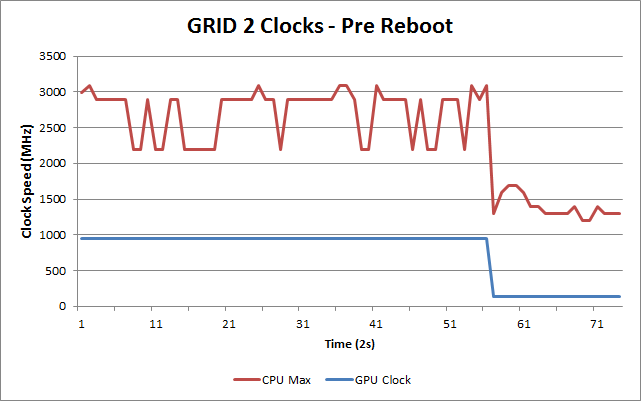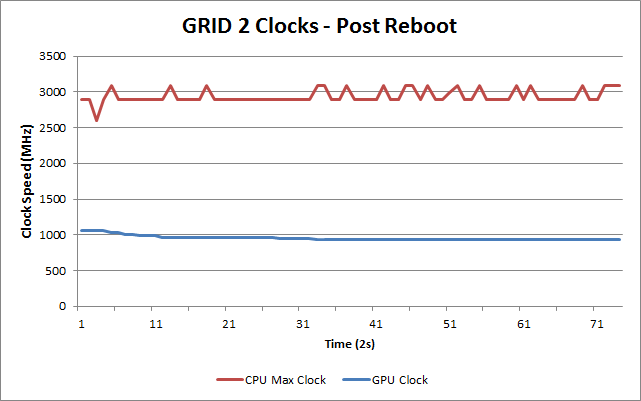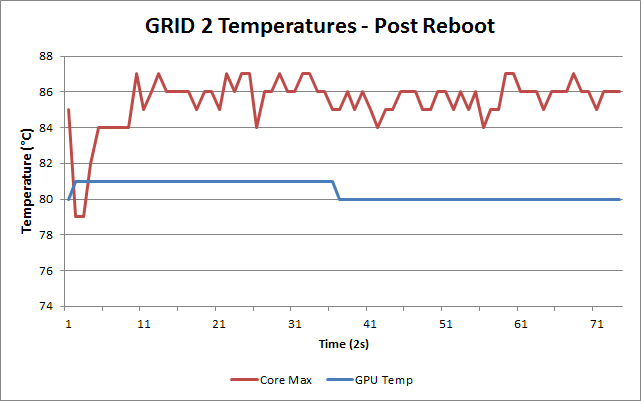Dell XPS 15 Haswell Edition: QHD+ with a Refined Design
by Jarred Walton on March 6, 2014 7:00 AM ESTDell XPS 15: Throttling or Not?
Before we get into the performance results, I want to veer off on a tangent for a bit. One of my biggest concerns with the new XPS 15 was whether there would be throttling – and if so, how it would take place. The previous XPS had a lot going for it, but the throttling was so bad that the discrete GPU was all but useless in practice. Here's a quick look at the internals of the new XPS 15, along with my attempts to improve cooling by replacing the thermal interface material.
So after unpacking the new XPS 15, the first thing I did was to start running some gaming benchmarks to see if any throttling was taking place. Everything looked good, with consistent performance in my first gaming benchmarks and GPU temperatures typically in the upper 70C range or lower. I continued on with running tests, found a few glitches that I brought up with Dell, and at one point a driver update from NVIDIA came out.
The initial drivers (Intel and NVIDIA) had an issue where playing games at non-native resulted in severe letterboxing (basically everything ran at 1:1 pixels on the display), so that was a problem that needed to be fixed. The updated drivers worked properly in this area, but as I commenced testing something became immediately apparent: GPU throttling was back, and it was quite severe. It’s at this point that I basically got lost in a web of troubleshooting, trying to figure out what was going on. Generally speaking, when the GPU hits 80C or more, the clocks start to drop, and in some cases things are apparently bad enough that the GPU simply gives up and runs at 135MHz core/405MHz GDDR5. As you can imagine, this makes running any game a very poor experience – running on just the iGPU would in most cases result in better performance.
So I rolled back the drivers, returned to the A00 BIOS, and tried many other things, all to no avail – I simply couldn’t reproduce my original gaming benchmark results. Then I opened the bottom of the laptop and tried running with the cover off, and things were a bit better, but there was still throttling and I couldn’t match the original scores. Much time and troubleshooting passed, and then I stumbled on a partial fix: running with the Balanced or Dell profiles appeared to produce better performance (and less throttling) than running on the High Performance profile…but some throttling still seemed to be going on.
By this time, I had two more or less identical XPS 15 laptops in house for testing and troubleshooting, both were behaving in a less than ideal manner as far as GPU clocks are concerned, and I decided I would make a video of the systems running the same tests side-by-side with one using the Dell power profile and the other using the Balanced power profile. In theory, these should be the same, other than the name, but I wasn’t quite sure. Before doing this, I also decided to make sure all the drivers, firmware, etc. were the same on both systems, so I grabbed the latest Dell and NVIDIA drivers, updated the BIOS to A02 on the original laptop, and got ready to shoot my video…and suddenly the throttling was gone…mostly. Ugh.
My best guess at this point was that an updated firmware that I applied for the touchscreen played a role, but I wasn’t certain of that. Running a pathological workload (e.g. Cinebench on seven CPU cores with Furmark on the GPU), it’s possible to get the GPU to throttle, but even there it’s not always as severe as what I experienced for a few weeks. As it stands, I have now tested the XPS 15 (many, many times!) in both 67F ambient and 80F ambient environments, and at least if it’s not too hot performance is basically where it should be for gaming. I haven’t found other talks of throttling either, so perhaps others were testing in cooler rooms or just not hitting the GPU as hard – or maybe it’s just a few specific games or other software where the issue crops up. To be clear, throttling of the GPU does still occur to some extent, but gaming really isn’t a top priority for this system and I think I’ve finally found the workaround.
To first illustrate what’s happening, here are the gaming performance results from my original testing (at our “Mainstream” settings), as well as testing with the latest drivers and firmware at ~67F and ~80F. I’ve normalized the performance to the 67F testing, and I don’t know what the ambient temperature was with my initial testing (probably around 70-75F).
| Dell XPS Performance | |||
| Initial Testing | 67F Updated Testing | 85F Updated Testing | |
| Bioshock Infinite | 112.1% | 100.0% | 100.0% |
| Elder Scrolls: Skyrim | 102.5% | 100.0% | 99.9% |
| GRID 2 | 89.0% | 100.0% | 100.5% |
| Metro: Last Light | 98.7% | 100.0% | 99.6% |
| Sleeping Dogs | 100.7% | 100.0% | 99.6% |
| StarCraft II: HotS | 98.6% | 100.0% | 99.8% |
| Tomb Raider 2013 | 106.7% | 100.0% | 99.8% |
In nearly all cases, the performance is basically equal between the hot and cold testing with the latest drivers, meaning any throttling is mild to non-existent. But there’s still more to discuss. Specifically, I was having problems with GRID 2 being a bit sporadic; the first benchmark run was usually fine, but subsequent runs sometimes ended up with worst-case throttling. In fact just before wrapping up this review, GRID 2 was consistently getting stuck at minimum GPU clocks. In a final effort to figure out what was going on, I logged clocks and temperatures, then rebooted and tested some more. Bingo. For more than five benchmark runs in a row everything is running fine. Yeah, it’s that sort of problem. Here are two charts of GRID 2, with the same settings in both cases, taken within the past 30 minutes – one before rebooting, and one after rebooting:
As you can see, prior to the reboot I was seeing high temperatures and severe throttling. It’s not a gradual throttling before the cutoff either – one second the GPU clocks are at 940/2500MHz and the next they drop to 135/405MHz. The GPU core reaches 88-89C and the CPU hits a maximum of 96C in my first set of benchmarks. In contrast, after a reboot I’m seeing more gradual (sensible) GPU clocks, with a maximum GPU temperature of 81C and a maximum CPU temperature of 87C, with no serious issues.
My conclusion at this point is that there’s some service, driver, or firmware that has some issues, and over time – running without a reboot – this builds up until the above throttling takes place. What specific workload causes this isn’t quite clear; normally when I’m using a laptop I don’t tend to reboot it on a regular basis, and in some cases that can mean days of use running many applications – in fact most of my computers only get rebooted when I apply a new driver or a Windows Update requires it. Anyway, there’s an old joke of sorts with tech support where the solution to many computer problems is to reboot the system. While that may help in many cases – and it certainly does here – this isn’t really a true solution; it’s a workaround. If all the drivers and software are running properly, OS reboots are not required to “fix” anything. As I haven’t been able to determine what exactly causes the system to get backed into these higher temperatures/throttling, all I can say for now is that if you do happen to encounter this glitch, try rebooting.
To summarize then, I don’t really have any remaining serious concerns with the GPU throttling, given the above workaround. If it starts to happen, you’ll know, and while a reboot is inconvenient in my experience it’s not usually required. I do feel Dell was perhaps overly conservative with the fan speeds and target GPU temperatures – and the inherent fan noise – but after being burned by RMA issues with NVIDIA’s G84/G86 back in 2007, I don’t really blame them. I’ve used other laptops that get a lot louder than the XPS 15, but while that might be annoying, to their credit I didn’t see any weird throttling issues. But then, I’ve also never tested a laptop with a QHD+ display before, so that’s a potential root cause (i.e. Intel and/or NVIDIA graphics drivers, and possibly firmware as well). There are 14” laptops with faster GTX 765M GPUs that are basically as thin as the XPS 15 (MSI GE40 and the Razer Blade 14 for example), so it’s not just a matter of size – something else is at play here. If you’re mostly looking for a multimedia or business type laptop, the discrete GPU isn’t really even needed these days – it might have been nice to see a version of the XPS 15 that kept all the other high end features (QHD+ display, pure SSD storage, larger battery) but dropped the GT 750M; there are people (Ganesh, for example) where that would be just about an ideal configuration.
And that’s enough talk about throttling. I’ve obsessed about this issue for much of the past two months, with solutions/workarounds that seemed to come and go. As you can imagine, ultimately determining that a reboot usually fixes the problem is less than satisfying from a troubleshooting perspective, but it’s far better than living with throttling. And the good news here: with an SSD the time it takes to reboot is only about 20 seconds.
As a final comment (and this is being written at 4AM), I spent the whole day and much of yesterday working on one of the XPS 15 laptops finishing this review. I ran some benchmarks, I had Chrome and Firefox running with dozens of tabs open, and I even loaded up a few games. That's all besides editing some images, downloading files, etc. I just reran the GRID 2 benchmark after all of that, and there was no throttling, so this isn't even something that would necessarily crop up daily. Still, it has happened in the past and I assume it will happen again. If Dell can provide a definitive fix for this issue, I’ll revisit this topic and make sure to let you know.


_thumb.JPG)
_thumb.JPG)
_thumb.JPG)
_thumb.JPG)
_thumb.JPG)
_thumb.JPG)












152 Comments
View All Comments
darwinosx - Thursday, March 6, 2014 - link
You could not play me to buy Dell anything. Cheap junk and forget about support after you buy.kgh00007 - Thursday, March 6, 2014 - link
How about the WiFi performance?The previous version had poor connection and throughput issues due to a design fault? Is this one any better?
My XPS 15 L502x, which is two generations behind this one, has the exact same throttling issues. I would not buyba laptop with any sign of throttling issues from the start, it will only get worse over time. Look for a laptop with good thermals from the start.
In order to game on my L502x with an i7-2360QM and GT525M, I have to set a "Game" profile with the CPU Max set to 99% to avoid turbo boost on the CPU so that it doesn't cook itself and the GPU. The heatsinks are connected just like they are in this newer model!
jphughan - Thursday, March 6, 2014 - link
WiFi had some issues early on in this system but they turned out to be driver-related. Intel released version 16.6 that seems to have fixed the vast majority of problems. Some people on NotebookReview are still having issues, but they haven't clarified what router or firmware they're running, so I consider those issues within the regular realm of WiFi performance/compatibility issues overall and not something specific to this particular system.dorekk - Monday, June 23, 2014 - link
That's weird, I've never noticed any throttling with my L502X.Dug - Thursday, March 6, 2014 - link
I've read that people have been very happy with the business equivalent which is the Dell Precision M3800. No throttling and seems to run cooler. I'm assuming because it uses the Nvidia Quadro K1100M, w/ 2GB GDDR5. I personally would get the 1080p panel. The scaling with high resolution displays is fine, until you plug in external monitors. Yes you can have different scaling between the laptop and external monitors but it's never plug and play. As soon as you disconnect them, you have to log off and back in to get the correct scaling on the laptop.jphughan - Thursday, March 6, 2014 - link
Or just take the acquisition of this laptop with a QHD+ panel as an excuse to buy a 4K panel! :D Of course that won't help if your apps don't handle scaling well at all as opposed to just having issues with regular DPI and HiDPI coexisting.I have the QHD+ version with a 24" 1200p external display and work around it by either not running the built-in panel at all when at my desk or running it at 1600x900. Yes switching to 3200x1800 and adjusting scaling requires a logoff and logon, which is somewhat irritating, but that's mostly because Microsoft only just delivered an API in Windows 8.1 that notifies applications when there's been a DPI scaling change, and thus those app developers haven't updated their apps to watch for and respond to that API notification. Remember back in Windows 95 when you had to restart your machine even when you changed your desktop resolution? That was true for the same reason, and it's been fixed because applications now watch for and respond to the resolution change notification. The same will happen with DPI scaling.
typicalGeek - Thursday, March 6, 2014 - link
After all the problems my kid has had with his XPS 15 (i5 - don't know exact model) in the 2.5 years he's had it, I would be pretty hard pressed to even consider one.The expensive "Crystal Clear HD" (or some such marketing BS) screen is useless unless viewed "head on" - only a few degrees off in either axis are unviewable, he's had problems with Dell's drivers (for the touchpad & DVD drive), and the 90W battery died without any warning. Still shows 100% charge on the status LEDs. Ha! Dell wanted $150 for a replacement battery, he ended up ordering one off Amazon for less than a third of that - and it included a 18 month warranty. Now his XPS keeps bugging him every start/boot that his battery is not genuine and that he should replace it. Does Dell <i><b>really</b></i> think they're going to convince someone to spend three times as much to get their battery by nagging them every day? All it really does is slow the boot process and tick off the customer. (Who probably isn't too keen that their battery didn't last much past the warranty in the first place.)
JBVertexx - Thursday, March 6, 2014 - link
My biggest beef with Dell now is their website and move to pre-configured models. It used to be so easy to go on the website and pick exactly what I wanted. I've tried numerous times in the last 4 months to go find something I would like, and it's just not there.There are too many models with too few options. The navigation is confusing, and there is no straightforward way to see ALL the models for a particular line you want.
I have a 4 year old Dell Latitude E6410, which was maxed out with the specs when I bought it. I've been happy with Dell laptops as my primary work and do-everything PC since I started buying them 16 years ago.
So instead of buying a new laptop, I just replaced my HDD with a 240GB SSD, then I bought one of the ODD bay adapters off ebay to fit a 750GB storage drive, and I'm all set for now. I'm starting to get in the hurt-locker with my NVS1100 graphics, and I'm starting to find cases where I could use more than 8GB RAM, but I guess I'll just have to suck it up for a while longer.
Really disappointed in what the website and their product lineup have become.
JBVertexx - Thursday, March 6, 2014 - link
Correction - that's NVS 3100M - still in the hurt-locker though.jphughan - Thursday, March 6, 2014 - link
Unfortunately pre-configured SKUs is the new deal. I think it's because in this smartphone/tablet era people overall are less concerned with menial options and more concerned with the overall product. That's not true of everyone of course, but fixed SKUs while continuing to only build to order means savings from a lean inventory and additional savings from fewer manufacturing variances and thus fewer chances of errors and rework.Still, Dell does appear to be passing the savings down to the consumer (likely because consumers are demanding lower prices for what is being seen more and more as a commodity/luxury than a necessity in the smartphone/tablet era). I remember my maxed out Precision M6300 back in the day cost $5200 before discounts. The modern-day equivalent of that system is the Precision M90, and even maxed out it costs less than half that -- despite inflation over the last 7 years. And it's certainly not because the Precision line has gone down the tubes.